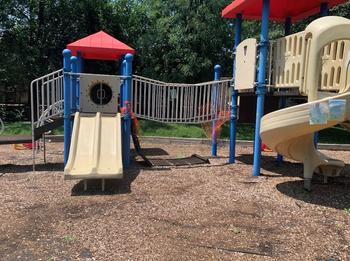In This Story
Immersing in the community is a core component of the global and community health curriculum at the College of Public Health. Community-based learning is the intentional engagement with the community to understand the social determinants of health (SDOH), which are defined as the conditions in which people are born, grow, work, live, and age as well as the broader systems that affect one’s life.
Adjunct faculty and GCH 360 instructor Shannyn Snyder is a strong advocate for community engagement in addition to in-class learning.

"Community-based learning helps students connect what they are learning in the classroom to real-world application, similar to experiential learning,” said Snyder. “CBL asks the student to look at the community around them and engage in a hands-on activity that will help them build a better understanding of how an environmental issue may be disproportionately affecting a population in that community.”
GCH 360 Health and Environment delves into SDOH and provides the opportunity to complete community-based learning (CBL) projects where students dedicate time to communities in Virginia, seeing how the biological, physical, and chemical factors in the environment affect a population. Students learn how public health principles can affect the communities around them.
“During the class, I was guided on research various topics regarding global and community health that I assumed would only apply to developing countries, not my neighborhood in the US. However, as I developed my project, all the health concerns discussed in class can still affect our neighborhoods,” said Hyewon Shim, a student in Snyder’s GCH 360 course.
For their CBL projects, students choose environmental health topics to address and are tasked with developing original solutions to their identified issue. Unlike traditional instruction methods, students go out to be within communities in northern Virginia.
“GCH 360 is a perfect way to practice getting to know a community, especially ones you may not be familiar with since it gives you the unique opportunity to explore and see beyond what you already know on a subject,” said Bethany Ditzler, who took Synder’s course this summer.
Mindy Lu, another student, chose to investigate the accessibility of playgrounds in Falls Church and gained a deeper appreciation for SDOH by completing her CBL project.
Lu’s CBL project centered around the environment as a SDOH, specifically how impactful outdoor play spaces can be on children's physical, mental, and emotional health. After assessing three locations, Lu identified causes for concern in multiple playgrounds. In a series of photographs Lu captured broken and missing equipment as well as pathways not compatible for safe walking.
Following her observations, Lu proposed forging stronger collaboration among community centers, non-profit organizations, and local governments to create safer play areas for the community’s children.
“Addressing the social determinants, and creating supportive environments in this specific case, needs the collaboration of various sectors in public health to make a substantial impact on improving health outcomes, reducing disparities, and fostering a healthier society for all,” Lu said.

Michelle Rivas, another GCH360 student, committed her time to trash cleanup in two Virginia neighborhoods.
After observing the notable amount of litter occurring, Rivas recommends installing more garbage disposal locations to make proper waste management easier for community members.
“This project allowed me to stop for a minute and think about how these environmental issues are impacting us directly, our planet, and how we can all do our part to help the planet and make our community better,” said Rivas
By the conclusion of the GCH 360 course, students are more eager than ever to go out and serve their communities.
“GCH 360 has taught me so much that I will carry on in the future as I engage with and advocate for communities impacted by issues such the one I addressed in my project,” said Rivas.
Like Rivas, Lu is more confident to successfully enter communities as a public health leader.
“Through the course, I learned to identify the underlying factors contributing to an issue. Armed with this knowledge, I now have the capacity to explore and propose potential solutions and interventions to address the problem effectively,” said Lu. “This newfound awareness empowers me to take proactive steps, advocate for change, and collaborate with others to make a positive impact on the well-being of my community.”
